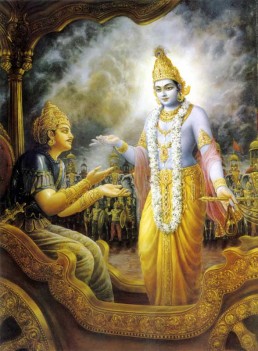Swami Chinmayananda
Swami Chinmayananda Commentary
In Vedanta, this relationship between the actionless Self and the active non-Self has been brought out by a bunch of analogies, each one trying to throw much light upon this sacred tie of ‘relationless-relationship.’
The rays of the Sun warm up the objects upon which they fall, without warming the intervening medium through which they pass. Similarly, the Self remains in Its own Infinite glory, and the non-Self gets dynamised to act, as Prakriti, in the mere “presence” of the Self.
The king gets a fancy that he should visit a given pilgrim centre on the full-moon day of the following month, and having expressed this intention to his minister, the king forgets all about it. But on the day prior to the following full-moon, the minister approaches the king to remind him that it is time for the royal procession. The next day, when the king comes out, he finds that the entire route is thronged with his subjects. Welcoming arches are raised at different places. All detailed arrangements are planned out and colourfully executed for his royal visit, and return. All the officers and subjects have poured out all their capacities and endeavour to make the royal trip to the temple a great success.
In all these feverish activities, everyone gained his authority and power only because of the king, and yet, the king himself was nowhere in the picture. The minister had his sanction from the king, and therefore, his orders were faithfully executed by all others. Had the minister tried to organise such a show as an ordinary citizen, he would never have succeeded. Similarly, in the mere presence of the Self, Prakriti borrows her sanction to plan and to execute, to act and to achieve.
Subjectively, this becomes more clear. The Atman, merely by Its “presence” illumines the mind and intellect and creates for the expression of their Vasanas an entire field of world-objects and the required instruments of experience, constituted of the organs-of-perception and the organs-of-action. “NATURE, WHILE I PRESIDE, GIVES BIRTH TO THE WORLD OF THINGS AND BEINGS” — “Nature” here means “The Unmanifest, that gets projected forth as the manifest.”
The continued dance of the world-of-plurality to the rhythm of change and death is maintained in the “presence” of the Self; “THE WORLD WHIRLS ROUND AND ROUND BECAUSE OF THIS.” In the final analysis, the Self does nothing. It is the Prakriti that projects and executes; the Prakriti that gets animated in the proximity of the Self. It is the Light of the Self that vitalises the Prakriti and makes her exist and act. That is all the relationship between the Self, the Purusha and the non-Self, the Prakriti.
This will become more clear if the student tries to understand this relationship exactly as the relationship that can exist between the wayside post and the ghost that is superimposed upon it by the deluded.
IF THE SELF BE THUS THE ESSENTIAL REALITY IN EVERY FORM AND IF IT BE EVER FREE FROM THE SORROWS AND TRIBULATIONS OF THE FINITE, WHY IS IT THAT ALL BEINGS ARE NOT ABLE TO IDENTIFY THEMSELVES WITH IT AND EXIST AS THE SELF?… LISTEN:
Adi Sankara Commentary
Maya, under Me; adhyaksena, as the supervisor, remaining changeless as a mere witness under all circumstances; prakrtih, the Prakrti, My maya consisting of the three gunas and characterized as ignorance; suyate, produces; the world sa-cara-acaram. of the moving and the none-moving things. Thus there is the Vedic text, ‘The one divine Being is hidden in all beings; He is amnipresent, the indwelling Self of all bengs, the Supervisor of actions, the refuge of all beings, the witness, the one who imparts consceiousness, unconditioned [This is according to Sankaracarya’s commentary on this verse. A.G. interprets kevala as non-dual.-Tr.] and without qualities’ (Sv. 6.11). Anena hetuna, owing to this reason-because of this presiding over; O son of Kunti, the jagat, world, with the moving and the non-moving things, consisting of the manifest and the unmanifest; viparivartate, revolves, under all conditions [During creation, continuance and dissolution.] All the activities of the world in the form, ‘I eat this; I see; I hear this; I experience this happiness, suffer this sorrow; I shall do this for that purpose, [Ast. omits this portion.-Tr] I shall do this for this purpose; I shall know this,’ etc. indeed arise owing to their being the objects of the conscious witness. They verily exist in consciousness, and end in consciousness. And such mantras as, ‘He who is the witness of this is in the supreme heaven’ [Supreme heaven, the heart; i.e. He is inscrutable.] (Rg., Na. Su. 10.129.7; Tai. Br.2.8.9), reveal this fact. Since it follows from this that there is no other conscious being part from the one Deity-who is the witness of all as the absolute Consciousness, and who in reality has no contact with any kind of enjoyment-, therefore there is no other enjoyer. Hence, in this context, the question, ‘For what purpose is this creation?’, and its answer are baseless-in accordance with the Vedic text, ‘Who know (It) truly, who can fully speak about this here? From where has this come? From where is this variegated creation?’ (Rg. 3.54.5; 10.129.6). And it has been pointed out by the Lord also: ‘Knowledge remains covered by ignorance. Thereby the creatures become deluded’ (5.15).
The Bhagavad Gita with the commentary of Sri Sankaracharya – Translated by Alladi Mahadeva Sastry
Holy Geeta – Commentary by Swami Chinmayananda
The Bhagavad Gita by Eknath Easwaran – Best selling translation of the Bhagavad Gita
The Bhagavad Gita – Translation and Commentary by Swami Sivananda
Bhagavad Gita – Translation and Commentary by Bhaktivedanta Swami Prabupadha
Srimad Bhagavad Gita Chapter 9 – Verse 10 – 9.10 mayadhyaksena prakrtih – All Bhagavad Gita (Geeta) Verses in Sanskrit, English, Transliteration, Word Meaning, Translation, Audio, Shankara Bhashya, Adi Sankaracharya Commentary and Links to Videos by Swami Chinmayananda and others – 9-10

